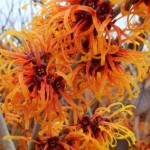Hamamelis is a genus of plants known for strap-like winter flowers and fall color. Many of the cultivars and species have fragrant flowers, a real treat on a dreary day in winter. The plants are relatively trouble free. They prefer a site that is well drained in full sun to part shade. Their preferred soil is acidic and organically rich. Prune the plants in the spring after they flower as needed to control shape and size. They can be planted in shrub borders, in woodland gardens, used as a screen or tall hedge. They make a good specimen where the winter flowers and fall color can be enjoyed.
The botanical name is from the Greek hama (together) and mela (fruit) as the flowers and fruit occur on the plant at the same time. The fruit remains on the plant for an entire year to ripen.
The common name derives from the Anglo-Saxon word, wych, meaning “to bend” and Hazel for the resemblance of the foliage to Corylus, the nutting hazels (or filberts as known in Oregon!). In colonial America, the shrubs flexible forked branches were used as “witching sticks” or “divining rod” to search out water.
This is the source of Witch Hazel, widely used as an astringent, tonic, and mild pain reliever.
This year, we have an assortment of container sizes, tree form and shrub form, and eight varieties to choose from:
Hamamelis intermedia ‘Angelly’ forms a compact, upright shrub with lightly fragrant, clear yellow flowers in the late winter to early spring. The new growth emerges yellow green, with some purple tints. The fall foliage color is yellow with orange highlights.
Hamamelis intermedia ‘Arnold Promise’ is a vigorous, upright spreading shrub with fragrant bright yellow flowers, reddish at the base, appearing in late winter. The flowers are uniquely twisted and ribbony. It tends to flower later than other selections. The fall color is yellow.
Hamamelis intermedia ‘Diane’ is a wide spreading shrub with unique, twisted, ribbon-like copper red flowers in late winter. The flowers appear even in cold, snowy conditions. The fall color is an outstanding combination of yellow, oranges, and reds.
Hamamelis intermedia ‘Jelena’ grows as a shrub or small tree with an open, spreading form. Softly fragrant, copper orange, ribbony flowers bloom in late winter. Dark green foliage turns red and orange in the fall. It was named for the wife of the Belgian developer, Robert de Belder, in 1954.
Hamamelis intermedia ‘Sunburst’ is a large, vase-shaped shrub with heavy clusters of bright yellow flowers in late winter. The flowers are not scented and are one of the last to bloom. Large broad, oval bright green leaves turn to yellow with some orange in the fall.
Hamamelis intermedia ‘Westerstede’ grows into a large upright shrub. Lightly fragrant, golden yellow, ribbon-like flowers appear in late winter. In the fall, the colors change to bright reds, oranges, and golds. Introduced by Heinrich Bruns, and named for the town where he once maintained a nursery.
Hamamelis mollis ‘Pallida’ is a broad-spreading, large shrub. The clear yellow, sweetly fragrant, wrinkled, strap like flowers appear in late winter. This selection is considered one of the best. The fall color is yellow to orange. It was grown and catalogued at Wisley Gardens, near London.
Hamamelis vernalis is a dense shrub with sweetly fragrant blooms. The flowers are yellow or orange in late winter. Fall color is golden-yellow. It is pH adaptable, and performs best in moist to wet situations. Takes full sun to shade.
- fall color
- flower in winter
- winter flowers
- Common Name:
- Height:
- Spread:
- Type:
- Zone:




